King of Fans 52TVR 52 inch Trieste User Manual
King of Fans, Inc. 52 inch Trieste
User Manual
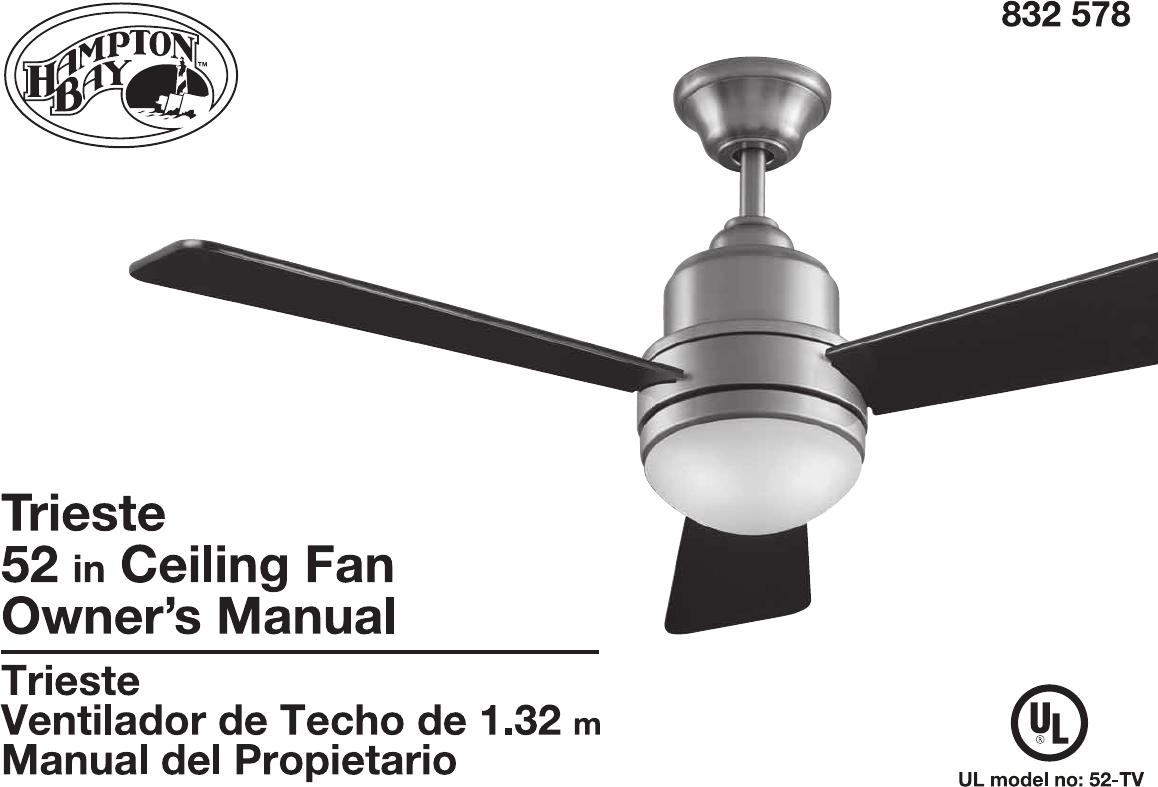

52” Trieste
Ceiling Fan by Hampton Bay
Ideal for Large Rooms
3-Speed Reverse Function for
Year-Round Comfort and Savings
Standard Handheld Remote
Control Included
Dual-Mount Installation
QUESTIONS, PROBLEMS, MISSING PARTS:
Before returning to your local Home Depot, please call our
Customer Service Team at 1-877-527-0313 or visit www.homedepot.com.
Please reference your SKU (832 578 brushed nickel)
or UPC (082392 680428 brushed nickel).
Thank you for purchasing this Hampton Bay ceiling
fan. This product has been manufactured with the
highest standards of safety and quality. The nish
of this fan is weather resistant, but over time will
naturally weather and fade.
Safety Rules .................................. 1
Unpacking Your Fan .................... 2
Installing Your Fan ...................... 3
Operating Your Fan ..................... 9
Operating Your Remote ............... 10
Care of Your Fan .......................... 11
Troubleshooting ............................ 11
Specications ................................ 12
Warranty Information ................. 13
Table of Contents
UL Model No. 52-TV

Safety Rules .................................. 1
Unpacking Your Fan .................... 2
Installing Your Fan ...................... 3
Operating Your Fan ..................... 9
Operating Your Remote ............... 10
Care of Your Fan .......................... 11
Troubleshooting ............................ 11
Specications ................................ 12
Warranty Information ................. 13
1. To reduce the risk of electric shock, insure electricity
has been turned off at the circuit breaker or fuse box
before beginning.
2. All wiring must be in accordance with the National
Electrical Code ANSI/NFPA 70-1999 and local electrical
codes. Electrical installation should be performed by a
qualied licensed electrician.
3. WARNING: To reduce the risk of re or electric shock,
this fan should only be used with fan speed control part no.
UC7067RYK, manufactured by Rhine Electronic Co., Ltd.
4. CAUTION: To reduce the risk of personal injury, use only
the screws provided with the electrical box.
5. The outlet box and support structure must be securely
mounted and capable of reliably supporting 35 lbs. (15.9
kg). Use only UL Listed outlet boxes marked “Acceptable
for Fan Support of 35 lbs. (15.9 kg) or less.”
6. The fan must be mounted with a minimum of 7 feet
clearance from the trailing edge of the blades to the oor.
7. Do not operate reversing switch while fan blades are in mo-
tion. Fan must be turned off and blades stopped before re-
versing blade direction.
8. Avoid placing objects in path of the blades.
9. To avoid personal injury or damage to the fan and
other items, be cautious when working around or
cleaning the fan.
10. Do not use water or detergents when cleaning the fan or fan
blades. A dry dust cloth or lightly dampened cloth will be
suitable for most cleaning.
11. After making electrical connections, spliced conductors
should be turned upward and pushed carefully up into
electrical box. The wires should be spread apart with
the grounded conductor and the equipment-grounding
conductor on one side of the electrical box and ungrounded
conductor on the other side of the electrical box.
12. Electrical diagrams are for reference only. Light kits that are
not packed with the fan must be UL Listed and marked suit-
able for use with the model fan you are installing. Switches
must be UL General Use Switches. Refer to the instructions
packaged with the light kits and switches for proper assembly.
13. All set screws must be checked and retightened where
necessary before installation.
Safety Rules 1.
READ AND SAVE THESE INSTRUCTIONS
TO REDUCE THE RISK OF FIRE, ELECTRIC SHOCK OR PERSONAL
INJURY, MOUNT TO OUTLET BOX MARKED “ACCEPTABLE FOR FAN
SUPPORT OF 35LBS. (15.9 KG) OR LESS”, AND USE SCREWS PRO-
VIDED WITH THE OUTLET BOX.
TO REDUCE THE RISK OF SHOCK. THIS FAN MUST BE INSTALLED
WITH AN ISOLATION WALL CONTROL/SWITCH.
TO REDUCE THE RISK OF PERSONAL INJURY, DO NOT BEND THE
BLADE BRACKETS (ALSO REFERRED TO AS (“FLANGES”) DURING
ASSEMBLY OR AFTER INSTALLATION. DO NOT INSERT OBJECTS IN
THE PATH OF THE BLADES.
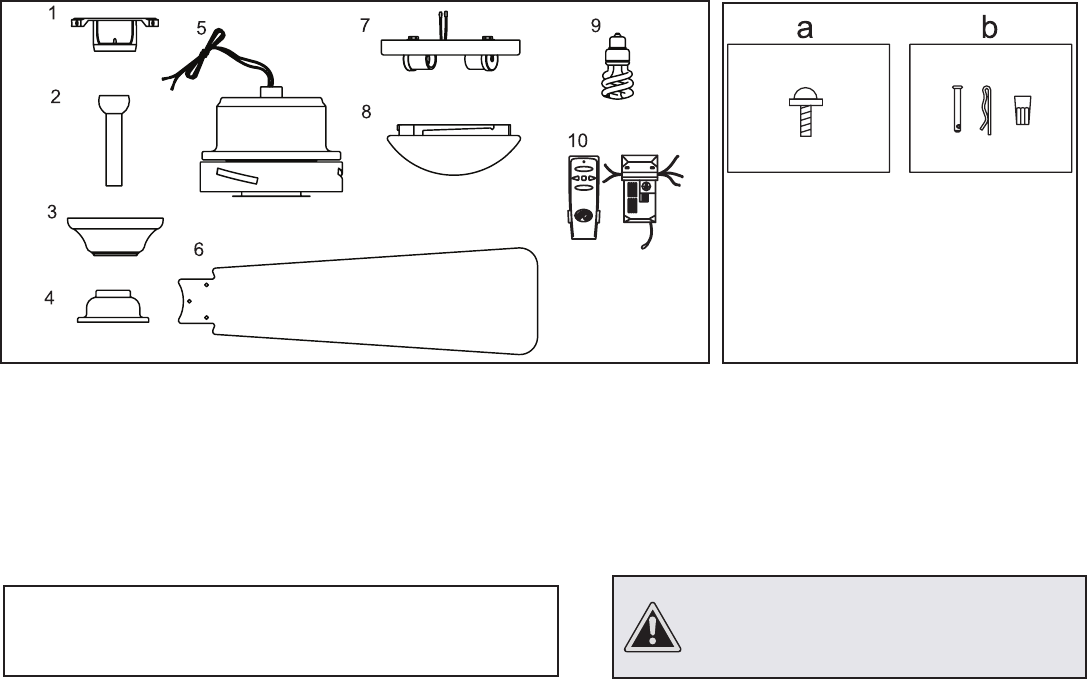
a. Blade attachment hardware
(9 Screws)
b. Mounting & Electrical Hardware
(1 hanger pin, 1 locking pin, 3 plastic wire
connectors)
7. Light Kit Assembly
8. Glass
9. Bulbs (2)
10. Hand Unit/Receiver
1. Mounting Plate (inside canopy)
2. Downrod and Ball Assembly
3. Canopy
4. Decorative Motor Collar Cover
5. Fan Motor Assembly
6. Blades (3)
2. Unpacking Your Fan
IMPORTANT: THIS PRODUCT AND/OR COMPONENTS ARE COVERED
BY ONE OR MORE OF THE FOLLOWING U.S. PATENTS: 5,947,436;
5,988,580; 5,971,573; 6,010,306; 6,039,541; 6,046,416 AND OTHER
PATENTS PENDING.
Unpack your fan and check the contents. You should have the following items:
OK
M
CAUTION: Changes or modications not expressly
approved by the party responsible for compliance
could void the user’s authority to operate the
equipment.
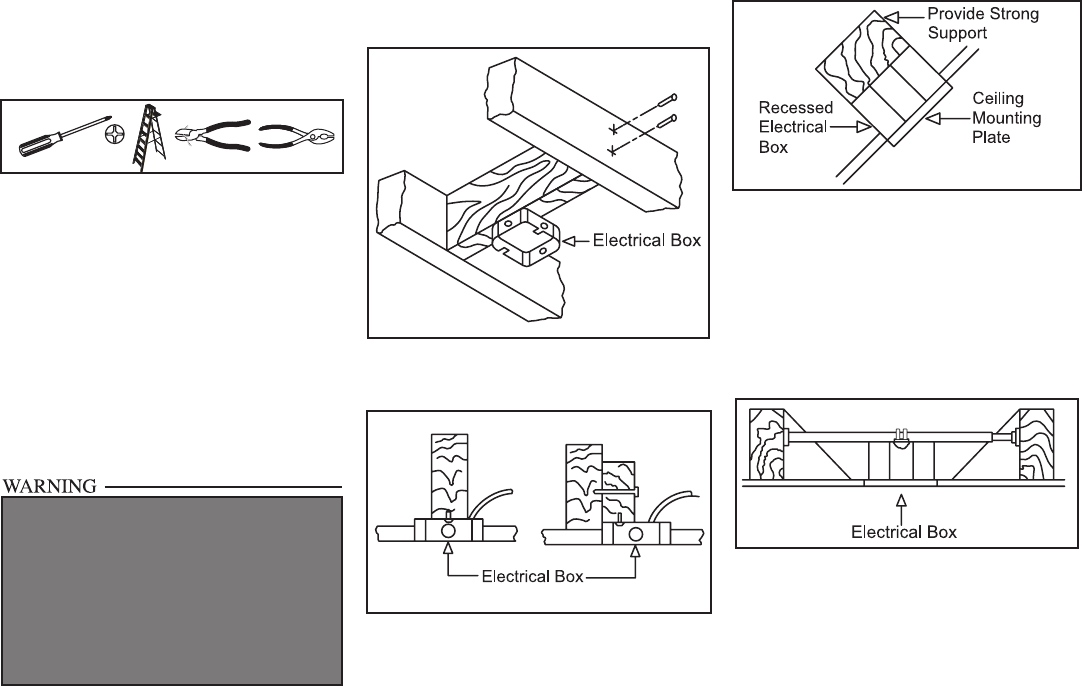
Installing Your Fan 3.
Tools Required
Phillips screw driver, straight slot screw
driver, adjustable wrench, step ladder, and
wire cutters.
Mounting Options
If there isn’t an existing electrical box, then
read the following instructions. Disconnect
the power by removing fuses or turning off
circuit breakers.
Secure the electrical box directly to the build-
ing structure. Use appropriate fasteners and
building materials. The electrical box and
its support must be able to fully support the
moving weight of the fan (at least 35 lbs.)
Do not use plastic electrical boxes.
Figures 1, 2, and 3 are examples of different
ways to mount the electrical box.
Note: You may need a longer downrod to
maintain proper blade clearance when install-
ing on a steep, sloped ceiling. The maximum
angle allowable is 30˚. If the canopy touches
downrod, remove the decorative canopy
bottom cover and turn the canopy 180˚ before
attaching the canopy to the mounting plate.
To hang your fan where there is an existing
xture but no ceiling joist, you may need an
installation hanger bar as shown in Figure 4
(available at your Hampton Bay retailer).
TO REDUCE THE RISK OF FIRE, ELECTRIC
SHOCK OR PERSONAL INJURY, MOUNT
TO OUTLET BOX MARKED “ACCEPTABLE
FOR FAN SUPPORT OF 35LBS. (15.9 KG) OR
LESS”, AND USE SCREWS PROVIDED WITH
THE OUTLET BOX. ELECTRICAL BOXES
COMMONLY USED FOR THE SUPPORT OF
LIGHTING FIXTURES MAY NOT BE ACCEPT-
ABLE FOR FAN SUPPORT AND MAY NEED TO
BE REPLACED. CONSULT A QUALIFIED ELEC-
TRICIAN IF IN DOUBT.
Figure 1
Figure 2
Figure 4
Figure 3
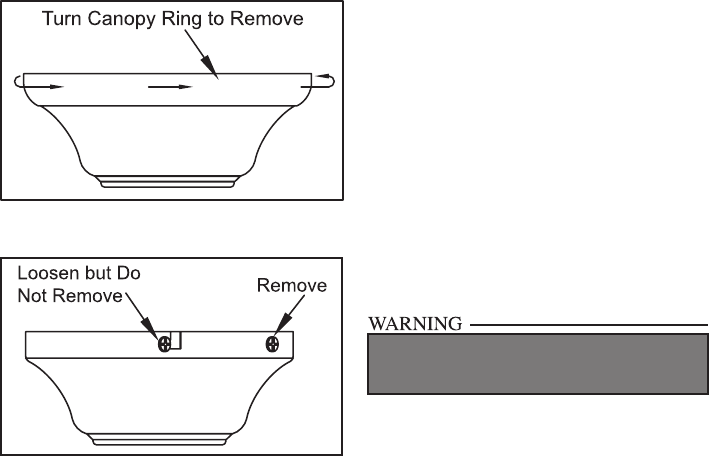
4.
Hanging the Fan
REMEMBER to turn off the pow-
er. Follow the steps below to hang your
fan properly.
NOTE: This fan is recommended for the
standard ceiling mounting using the downrod
provided with this fan. When using standard
ceiling installation with the 6 inch downrod
provided, the distance from the ceiling to the
bottom of the fan blades will be approximate-
ly 12 inches.
Standard Ceiling Mounting
1. Remove the canopy ring from the canopy
by turning the ring to the right until it
unlocks (Figure 5).
2. Remove the mounting plate from the
canopy by loosening the four screws on
the top of the canopy. Remove the two
non-slotted screws and loosen the slotted
screws. This will enable you to remove the
mounting plate (Figure 6).
3. Route the wires exiting the top of the
fan motor through the decorative motor
collar cover then the canopy ring. Make sure
the slot openings are on top. Route the wires
through the canopy and then through the
ball/downrod assembly (Figure 7).
Figure 5
Figure 6
4. Loosen, but do not remove, the set
screws on the collar on the top of the
motor housing.
5. Align the holes at the bottom of the
downrod with the holes in the collar
on top of the motor housing (Figure 7).
Carefully insert the hanger pin through
the holes in the collar and downrod. Be
careful not to jam the hanger pin against
the wiring inside the downrod. Insert the
locking pin through the hole near the
end of the bolt until it snaps into its
locked position, as noted in the circle inset
of Figure 7.
6. Re-tighten the set screws on the collar on top
of the motor housing.
7. Make sure the grommet is properly installed
in the collar cover, then slide the collar cover
on the downrod until it rests on the motor
housing. Be sure that the canopy and the col-
lar cover are both oriented correctly.
8. Proceed to “Installing the Fan” section.
FAILURE TO PROPERLY INSTALL SET SCREWS
AS NOTED IN STEP 6 COULD RESULT IN FAN
LOOSENING AND POSSIBLY FALLING.
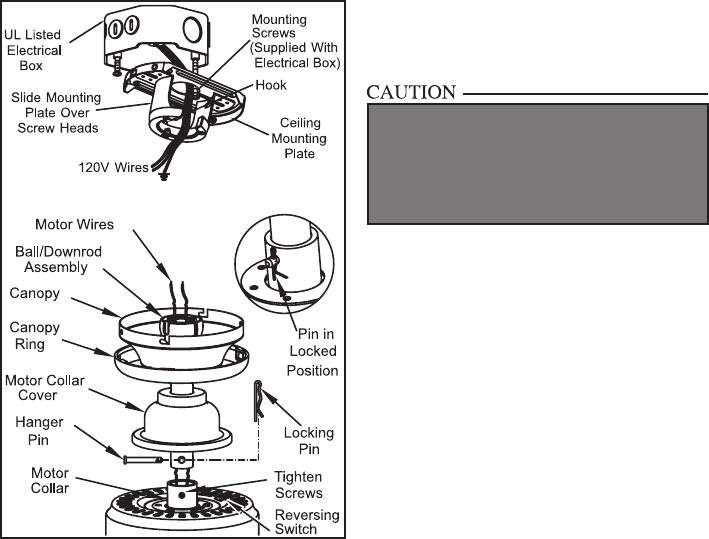
5.
Figure 7
Installing Fan to
the Electrical Box
WHEN MOUNTING THE FAN ON A SLOPED
CEILING, THE STANDARD BALL/DOWNROD
MOUNTING METHOD MUST BE USED. THE
MOUNTING PLATE MUST BE MOUNTED SO
THAT THE SLOT OPENINGS ARE ON THE
LOWER SIDE BY SLIDING THE MOUNTING
PLATE FROM THE TOP DOWN.
1. Pass the 120-volt supply wires through the
center hole in the ceiling mounting plate as
shown in Figure 7.
2. Install the ceiling mounting plate on the
electrical box, by sliding the mounting
plate over the two screws provided with the
electrical box (Figure 7). If necessary, use
leveling washers (not included) between the
mounting plate and the electrical box. Note
that the at side of the mounting plate is to-
ward the electrical box (Figure 7).
3. Securely tighten the two mounting screws.
4. Carefully lift the fan assembly up to the
ceiling mounting plate. Make sure the tab
on the mounting plate is properly seated in
the groove in the hanger ball.
Making the Electrical
Connections
REMEMBER to disconnect the power. If
you feel you do not have enough electrical
wiring knowledge or experience, have your fan
installed by a licensed electrician.
Follow the steps below to connect the fan
to your household wiring. Use the wire
connecting nuts supplied with your fan
and supplied with remote control. Se-
cure the connectors with electrical tape.
Make sure there are no loose strands or
connections (Figure 8).
1. Connect the ground conductor of the 120v
supply (this may be a bare wire or a wire
with green colored insulation) to the green
ground lead(s) of the fan (Figure 8).
2. Connect the fan motor white wire to
the receiver white wire using a wire nut
(Figure 8).
3. Connect the fan motor black wire to
the receiver black wire using a wire nut
(Figure 8).
4. Connect the fan motor blue wire to the re-
ceiver blue wire using a wire nut (Figure 8).
5. Connect the receiver black wire to the
supply black (hot) wire using a wire nut
(Figure 8).
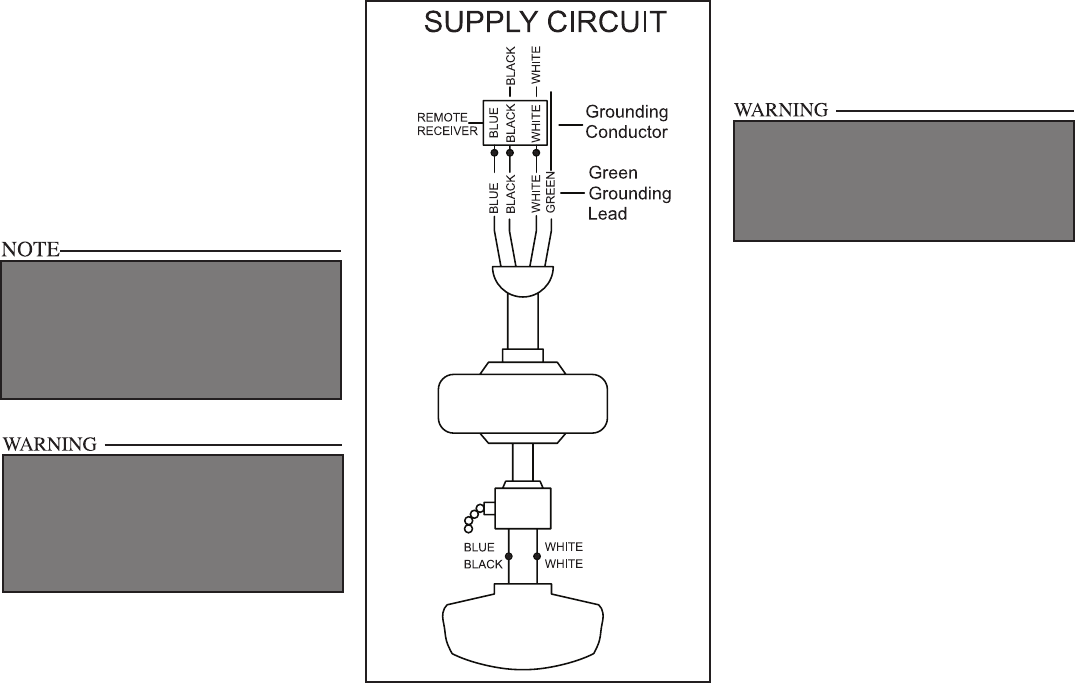
6.
6. Connect the receiver white wire to the sup-
ply white wire (neutral) wire using a wire
nut (Figure 8).
7. After connecting the wires, spread them
apart so that the green and white wires are
one side of the electrical box and the black
wire is on the other side.
8. Turn the wire connecting nuts upward and
carefully push the wiring into the electrical
box.
EACH WIRE NUT (WIRE CONNECTOR) SUP-
PLIED WITH THIS FAN IS DESIGNED TO ACCEPT
UP TO ONE 12 GAUGE HOUSE WIRE AND TWO
WIRES FROM THIS FAN. IF YOU HAVE LARGER
THAN 12 GAUGE HOUSE WIRING OR MORE
THAN ONE HOUSE WIRE TO CONNECT TO THE
FAN WIRING, CONSULT AND ELECTRICIAN FOR
THE PROPER SIZE WIRE NUTS TO USE.
THE FREQUENCIES ON YOUR RECEIVER AND
TRANSMITTER HAVE BEEN PRESET AT THE
FACTORY. BEFORE INSTALLING THE RECEIV-
ER, MAKE SURE THE DIP SWITCHES ON THE
RECEIVER AND TRANSMITTER ARE SET TO
THE SAME FREQUENCY. THE DIP SWITCHES
ON THE TRANSMITTER ARE LOCATED INSIDE
THE BATTERY COMPARTMENT.
Finishing the Fan
Installation
STANDARD CEILING MOUNTING
1. Align the locking slots of the ceiling canopy
with the two screws in the mounting plate.
Push up to engage the slots and turn clock-
wise to lock in place. Immediately tighten
the two mounting screws rmly.
2. Install the remaining two mounting
screws into the holes in the canopy and
tighten rmly.
3. Install the decorative canopy ring by
aligning the ring’s slots with the screws
in the canopy. Rotate the ring counter-
clockwise to lock in place.
4. You may now proceed to attaching the
fan blades.
WHEN USING THE STANDARD BALL/DOWNROD
MOUNTING, THE TAB IN THE RING AT THE BOT-
TOM OF THE MOUNTING PLATE MUST REST IN
THE GROOVE OF THE HANGER BALL. FAILURE
TO PROPERLY SEAT THE TAB IN THE GROOVE
COULD CAUSE DAMAGE TO WIRING.
Figure 8
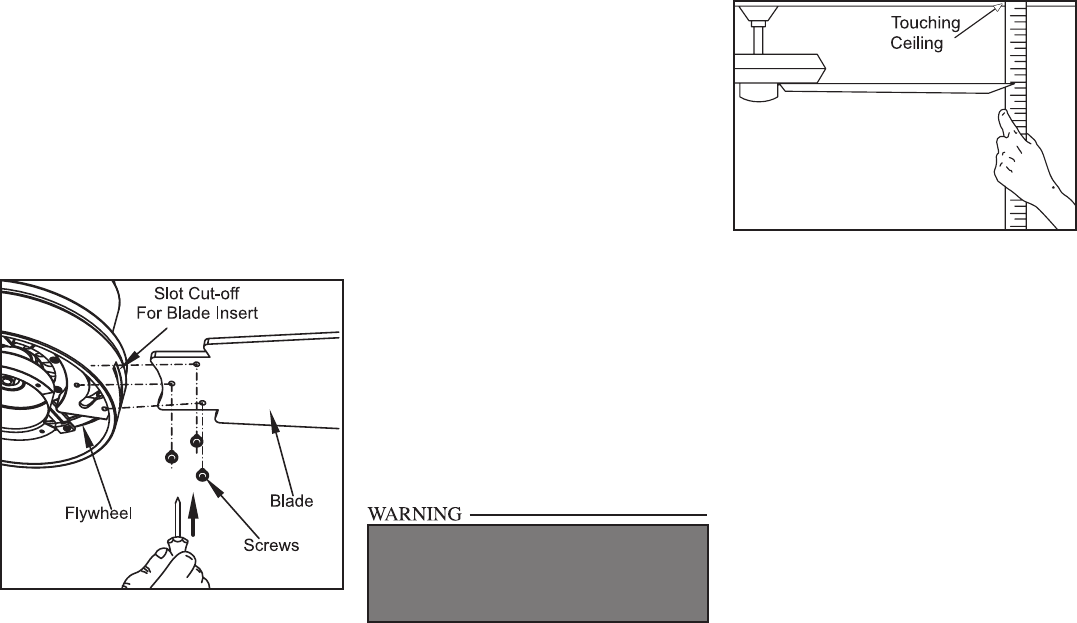
7.
Attaching the
Fan Blades
1. Insert the blade through the slot cut-off in
the center ywheel, align the three screw
holes in the blade with the screw holes in
the ywheel and secure with the screws pro-
vided (Figure 9).
2. Repeat for the remaining blades.
Figure 9
Figure 10
Blade Balancing
All blades are grouped by weight. Because nat-
ural woods vary in density, the fan may wobble
even though the blades are weight matched.
The following procedure should correct most
fan wobble. Check after each step.
1. Check that all blade screws are secure.
2. Most fan wobble problems are caused when
blade levels are unequal. Check this level by
selecting a point on the ceiling above the tip
of one of the blades. Measure from a point
on the center of each blade to the point on
the ceiling. Measure this distance as shown
in Figure 10. Rotate the fan until the next
blade is positioned for measurement. Re-
peat for each blade. Measurement devia-
tions should be within 1/8”. Run the fan for
10 minutes. If the fan continues to wobble
please contact Customer Service and a ba-
lacing kit will be sent to you at no charge.
TO REDUCE THE RISK OF PERSONAL INJURY,
DO NOT BEND THE BLADE HOLDERS WHILE
INSTALLING, BALANCING THE BLADES, OR
CLEANING THE FAN. DO NOT INSERT FOREIGN
OBJECTS BETWEEN ROTATING BLADES.
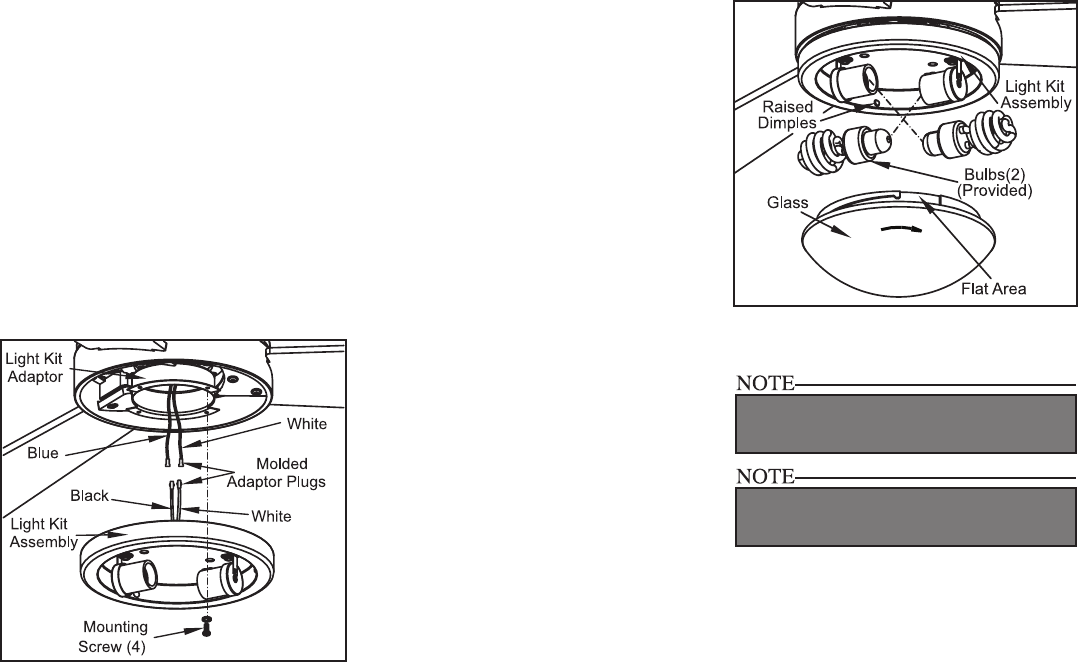
8.
Installing the Light
Kit/ Glass Bowl
CAUTION - To reduce the risk of electrical
shock, disconnect the electrical supply circuit to
the fan before installing the light kit.
THE GLASS IS FRAGILE, USE ACRE WHEN
INSTALLING THE LIGHT KIT AND THE
GLASS SHADE.
1. Loosen but do not remove three of four
mounting screws from the light kit adaptor
below the fan motor assembly; remove one
mounting screw (Figure 11).
2. Connect the blue and white wires exiting the
light kit adaptor with the black and white
wires from the light kit assembly by engag-
ing the molded adaptor plugs (blue to black;
white to white).
3. Carefully tuck connectors into the light
kit adaptor. Position the light kit assembly
onto the light kit adaptor, aligning each of
the four holes. Rotate the light kit assem-
bly clockwise to engage the three mounting
screws with the three key hole slots, tighten
the screws. Re-install the one mounting
screw that was removed in step 1 and tighten
rmly.
4. With power off, install the two uorescent
bulbs (Max. 14W, supplied) by screwing
into the light bulb sockets (Figure 12).
5. Place the glass shade into the light kit as-
sembly, aligning the three at areas on the
top ange of the glass shade with the three
raised dimples in the light kit assembly.
Turn the glass shade clockwise until it stops
(Figure 12).
Figure 11
Figure 12
PERIODICALLY CHECK THE GLASS IS SEAT-
ED FULLY CLOCKWISE IN THE LIGHT KIT
ASSEMBLY.
ALLOW THE BULB TO COOL COMPLETELY BE-
FORE TOUCHING OR REPLACING THE BULBS
TO AVOID ACCIDENTAL BURNING OF THE SKIN.
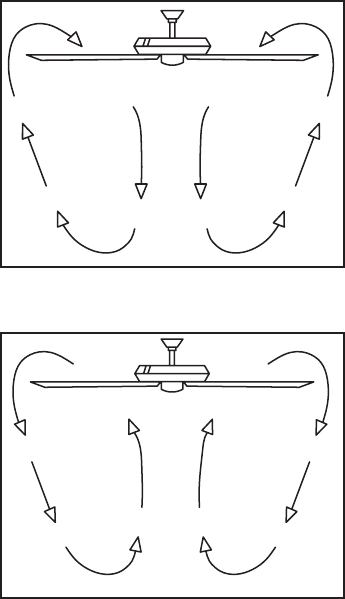
Operating Your Fan 9.
Speed settings for warm or cool weather
depend on factors such as room size, ceil-
ing height, number of fans, and so on.
The fan shipped from the factory with the
reversing switch positioned to circulate air
downward. If airow is desired in the op-
posite direction, turn your fan off and wait
for the blades to stop turning, then slide the
reversing switch (located at the top of the
motor housing, refer to gure 7 on page 5)
to opposite position, and turn fan on again.
The fan blades will turn in the opposite di-
rection and reverse airow.
Figure 13
Figure 14
Warm weather - (Forward) A downward
air ow creates a cooling effect as shown
in Figure 13. This allows you to set your
air conditioner on a higher setting without
affecting your comfort.
Cool weather - (Reverse) An upward air
ow moves warm air off the ceiling are as
shown in Figure 14. This allows you to set
your heating unit on a lower setting with-
out affecting your comfort.
10. Operating Your Remote Control
Operating the Fan:
Hi Key - High Speed
Med Key - Medium Speed
Low Key - Low Speed
Off Key - Power Off
Light Key - Light On/Off
Remote Control
Your fan is equipped with a remote control
to operate the speed and lights of your new
ceiling fan. For more information on how
to install the remote control, see the remote
control instruction along with the remote
control components.
Transmitter Operation
NOTE: This remote is equipped with 16 code
combinations. To prevent possible interference
from or to other remote units such as garage
door openers, car alarm or security system,
simply change the combination code but be
sure that the code on both the hand held trans-
mitter and receiver in the fan are matched.
Install a 9 volt battery (not included).
Setting the Code
This unit has 16 different code combinations.
To set the code, perform the following steps:
A. Setting the code on the transmitter:
a. Remove the battery cover. Press rmly
below arrow and slide battery cover off.
b. Slide code switches to your choice of up
or down position. (Factory setting is all up).
B. Setting the code on the receiver.
a. Slide code switches to the same position
as set on your transmitter.
b. Replace battery cover on transmitter.
CAUTION:
Ceiling angle shall not exceed 30 degrees.
Controller Model: UC7067RYK

Care of Your Fan and Troubleshooting 11.
Care of Your Fan
Here are some suggestions to help you
maintain your fan.
1. Because of the fan’s natural movement,
some connections may become loose.
Check the support connections, brackets,
and blade attachments twice a year. Make
sure they are secure. (It is not necessary to
remove fan from ceiling.)
2. Clean your fan periodically to help maintain
its new appearance over the years. Do not
use water when cleaning, this could damage
the motor, or the wood or possibly cause
an electrical shock. Use only a soft brush
or lint-free cloth to avoid scratching the
nish. The plating is sealed with a lacquer
to minimize discoloration or tarnishing.
Warning - Make sure the power is off
before cleaning your fan.
3. You can apply a light coat of furniture pol-
ish to the wood for additional protection
and enhanced beauty. Cover small scratches
with a light application of shoe polish.
4. There is no need to oil your fan.
The motor has permanently lubricated
sealed ball bearings. MAKE SURE THE POWER IS OFF AT THE ELECTRICAL PANEL BOX BE-
FORE YOU ATTEMPT TO MAKE ANY REPAIRS. REFER TO THE SECTION,
“MAKING ELECTRICAL CONNECTIONS.”
Fan will not start
Fan sounds noisy
1. Check main and branch circuit fuses or breakers
2. Check line wire connections to the fan and switch wire connections in
the switch housing. CAUTION: Make sure main power is off.
3. Check batteries in the transmitter. Does the red LED light come on? Are
you standing close enough to the fan? (Normal range is 10-20 feet.) Are
the dip switch settings the same on the transmitter (hand unit) and re-
ceiver? REMEMBER TO TURN OFF POWER SUPPLY BEFORE
CHECKING THE DIP SWITCH SETTINGS IN RECEIVER.
1. Make sure all motor housing screws are snug.
2. Make sure the screws that attach the fan blade bracket to the motor hub
are tight.
3. Make sure wire nut connections are not rattling against each other or
the interior wall of the switch housing.
CAUTION: Make sure power is off.
4. Allow a 24-hour “breaking in” period. Most noises associated with a
new fan disappear during this time.
5. If using the Ceiling Fan light kit, make sure the screws securing the
glassware are tight. Check that the light bulb is also secure.
6. Make sure the canopy is a short distance from the ceiling.
It should not touch the ceiling.
7. Make sure your electrical box is secure and rubber isolator pads were
used between the mounting bracket and electrical box.
Troubleshooting
Problem Solution

interference, and (2) this device must accept any interference received, including interference that may cause undesired operation.
This device complies with part 15 of the FCC Rules. Operation is subject to the following two conditions: (1) This device may not cause harmful
,
CAUTION: Any changes or modifications not expressly approved by the grantee of this device could void the user' s authority to operate the equipment.
--Consult the dealer or an experienced radio/TV technician for help.
--Connect the equipment into an outlet on a circuit different from that to which the receiver is connected.
--Increase the separation between the equipment and receiver.
--Reorient or relocate the receiving antenna.
following measures:
reception, which can be determined by turning the equipment off and on, the user is encouraged to try to correct the interference by one or more of the
there is no guarantee that interference will not occur in a particular installation. If this equipment does cause harmful interference to radio or television
frequency energy and, if not installed and used in accordance with the instructions, may cause harmful interference to radio communications. However,
designed to provide reasonable protection against harmful interference in a residential installation. This equipment generates, uses and can radiate radio
This equipment has been tested and found to comply with the limits for a class B digital device, pursuant to Part 15 of the FCC Rules. These limits are
Specications 12.
FAN SIZE SPEED VOLTS AMPS WATTS RPM CFM NET
WEIGHT
GROSS
WEIGHT
CUBE
FEET
52”
Low 120 0.29 13 64 1584
18.7 Lbs 21.2
Lbs 1.76Med 120 0.44 33 128 3234
High 120 0.52 62 175 4575
These are approximate measures. They do not include Amps and Wattage used by the light kit.
Distributed by Home Depot U.S.A., Inc.
2455 Paces Ferry Rd. N.W. Atlanta, Georgia 30339
Vendor Number: 11688

Warranty Information 13.
Hampton Bay Lifetime Limited Warranty
Lifetime Warranty on Motor
Hampton Bay warrants the fan motor to be free from defects in workmanship and material present at
time of shipment from the factory for a lifetime after the date of purchase by the original purchaser.
Hampton Bay also warrants that all other fan parts, excluding any glass or acrylic blades, to be free
from defects in workmanship and material at the time of shipment from the factory for a period of
one year after the date of purchase by the original purchaser. We agree to correct such defects with-
out charge or at our option replace with a comparable or superior model if the product is returned to
Hampton Bay. To obtain warranty service, you must present a copy of the receipt as proof of pur-
chase. All costs of removing and reinstalling the product are your responsibility. Damage to any part
such as by accident or misuse or improper installation or by afxing any accessories, is not covered
by this warranty. Because of varying climatic conditions, this warranty does not cover any changes
in plated nishes, including rusting, pitting, corroding, tarnishing or peeling. Brass nishes of this
type give their longest useful life when protected from varying weather conditions. A certain amount
of “wobble” is normal and should not be considered a defect. Servicing performed by unauthorized
persons shall render the warranty invalid. There is no other express warranty. Hampton Bay hereby
disclaims any and all warranties, including but not limited to, those of merchantability and tness
for a particular purpose to the extent permitted by law. The duration of any implied warranty which
cannot be disclaimed is limited to the time period as specied in the express warranty. Some states
do not allow limitation on how long an implied warranty lasts, so the above limitation may not apply
to you. Hampton Bay shall not be liable for incidental, consequential, or special damages arising out
of or in connection with product use or performance except as may otherwise be accorded by law.
Some states do not allow the exclusion of incidental or consequential damages, so the above exclu-
sion or limitation may not apply to you. This warranty gives specic legal rights, and you may also
have other rights which vary from state to state. This warranty supersedes all prior warranties. Ship-
ping costs for any return of product as part of a claim on the warranty must be paid by the customer.
IMPORTANT NOTE:
To ensure warranty service, if ever
necessary, please register your fan at:
gpwarranty.com
You must present a copy of the original
purchase receipt to obtain warranty service.
G.P. WARRANTY SERVICE CENTER, INC.
WARRANTY SECTION
1951 N.W. 22nd STREET
FORT LAUDERDALE, FLORIDA 33311
Attach receipt here for
easy location.

Trieste de 52”
Ventilador de techo de Hampton Bay
Ideal para habitaciones grandes
Función de reversa de 3 velocidades para
confort y ahorro durante todo el año
Incluye control remoto portátil estándar
Instalación de montaje doble
¿PREGUNTAS, PROBLEMAS O PIEZAS FALTANTES?
Antes de volver a tu tienda local de The Home Depot, por favor llama a nuestro Equipo de
Servicio al Cliente al 1-877-527-0313 o visita www.homedepot.com.
Por favor usa como referencia el Nº de SKU (832 578 níquel cepillado)
o UPC (082392 680428 níquel cepillado).
Gracias por comprar este ventilador de techo de
Hampton Bay. Este producto se ha fabricado con las
normas de seguridad y calidad más altas. El acabado
de este ventilador es resistente a la intemperie, pero
con el tiempo, exhibirá un desgaste y decoloración
naturales.
Normas de seguridad .......................1
Cómo desempacar el ventilador .......2
Cómo instalar el ventilador .............3
Cómo operar el ventilador ...............9
Cómo manajarel control remoto ......10
Cuidado del ventilador .....................11
Solución de problemas ...................... 11
Especicaciones ................................. 12
Información de la garantía ...............13
Índice
No. de Modelo UL 52-TV

1. Para disminuir el riesgo de descarga eléctrica, asegúrate de
que la electricidad ha sido apagada en el cortacircuitos o la
caja de fusibles antes de comenzar la instalación.
2. Todo el cableado debe cumplir con el Código Nacional de
Electricidad ANSI/NFPA 70-1999 y con los códigos locales
de electricidad. La instalación eléctrica debe ser hecha por
un electricista autorizado y calicado.
3. ADVERTENCIA: Para disminuir el riesgo de incendio o
descarga eléctrica este ventilador sólo debe ser usado con
un control identicado con el N.o de pieza UC7067RYK,
fabricado por Rhine Electronic Co., Ltd.
4. PRECAUCIÓN: Para reducir el riesgo de lesiones físicas,
usa sólo los tornillos provistos con la caja de distribución.
5. La caja eléctrica y estructura de soporte deben montarse
de forma segura y tener capacidad para sostener de manera
conable 35 lb. Usa solamente cajas eléctricas aprobadas
por UL marcadas como “Aprobada como soporte de ventila-
dores de 35 lb (15,9 kg) o menos.”
6. El ventilador debe ir montado con un mínimo de 7 pies de
separación entre el borde trasero de las aspas y el piso .
7. No operar el interruptor de reversa mientras las aspas del
ventilador estén en movimiento. El ventilador debe estar
apagado y las aspas detenidas antes de invertir la dirección
del movimiento.
8. Evita colocar objetos en la trayectoria de las aspas.
9. Para evitar lesiones, o daños al ventilador y otros objetos;
ten cuidado al trabajar cerca del ventilador o al limpiarlo.
10. No usar agua o detergentes para limpiar el ventilador o las
aspas. En general a la hora de limpiar, bastará con usar un
paño seco o ligeramente humedecido.
11. Después de concluir con las conexiones eléctricas, debes
voltear los conductores empalmados hacia arriba y empujar-
los con cuidado hacia dentro de la caja de distribución. Los
cables deben estar separados, con el cable a tierra y el con-
ductor a tierra del equipo hacia uno de los lados de la caja
de distribución y el conductor sin conexión a tierra hacia el
lado opuesto.
12. Los diagramas eléctricos son sólo una referencia. Los kits de
luces no empaquetados con el ventilador deben estar aproba-
dos por UL y marcados como apropiados para ser usados con
el modelo de ventilador a instalar. Los interruptores deberán
estar clasicados por UL como de Uso General. Consulta las
instrucciones adjuntas a los kits de luces e interruptores para
obtener información sobre el ensamblado adecuado.
13. Todos los tornillos colocados se deben vericar y ajustar
donde sea necesario antes de la instalación
1. Normas de seguridad
LEE LAS INSTRUCCIONES Y GUÁRDALAS
PARA REDUCIR EL RIESGO DE INCENDIO, DESCARGA ELÉCTRICA O
LESIONES PERSONALES, MONTA EL VENTILADOR SOBRE UNA CAJA
ELÉCTRICA MARCADA COMO “APROBADA COMO SOPORTE DE VEN-
TILADORES DE 35 LB (15,9 KG) O MENOS”, Y USA LOS TORNILLOS DE
MONTAJE QUE VIENEN CON LA MISMA.
PARA REDUCIR EL RIESGO DE LESIONES PERSONALES, NO DOBLAR
LOS BRAZOS DE LAS ASPAS (TAMBIÉN LLAMADOS “REBORDES”)
DURANTE O DESPUÉS DE LA INSTALACIÓN. NO COLOCAR OBJETOS
EN MEDIO DE LA TRAYECTORIA DE LAS ASPAS.
PARA REDUCIR EL RIESGO DE DESCARGA ESTE VENTILADOR DEBE
SER INSTALADO CON UN CONTROL/INTERRUPTOR DE AISLAMIENTO
DE MONTAJE EN PARED.
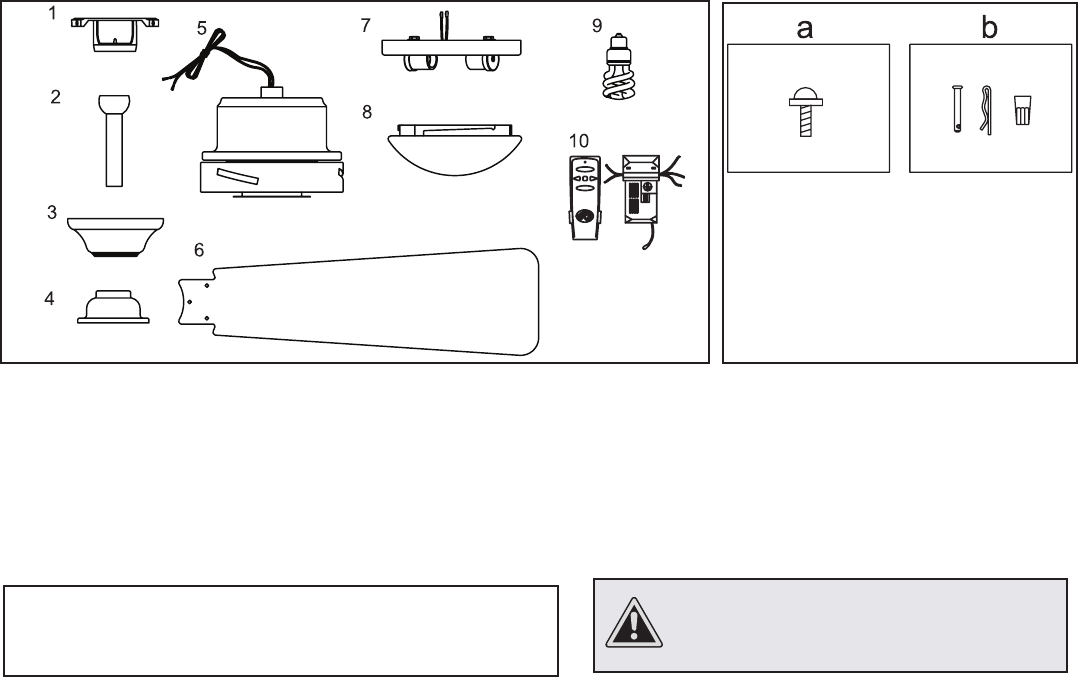
a. Herrajes de montaje de aspas
(9 tornillos)
b. Herrajes de montaje y electricidad
(1 pasador de apoyo, 1 pasador de cierre,
3 cables conectores de plástico)
7. Ensamblado del kit de luces
8. Vidrio
9. Bombillas (2)
10. Unidad de mano/Receptor
1. Placa de montaje (dentro de la cubierta)
2. Ensamblado de tubo bajante y bola
3. Cubierta
4. Cubierta decorativa del collarín del motor
5. Ensamblaje del motor del ventilador
6. Aspas (3)
Cómo desempacar el ventilador 2.
IMPORTANTE: ESTE PRODUCTO Y/O SUS COMPONENTES ESTÁN
PROTEGIDOS POR UNA O MÁS DE LAS SIGUIENTES PATENTES DE
EE.UU.: 5,947,436; 5,988,580; 5,971,573; 6,010,306; 6,039,541; 6,046,416
Y OTRAS PATENTES PENDIENTES.
Desempaca tu ventilador y revisa el contenido. Deberá tener las siguientes piezas:
OK
M
PRECAUCIÓN: Cambios o modicaciones sin la
aprobación expresa por el parido responsable del
cumplimiento pueden anular la autoridad para
operar el equipo.
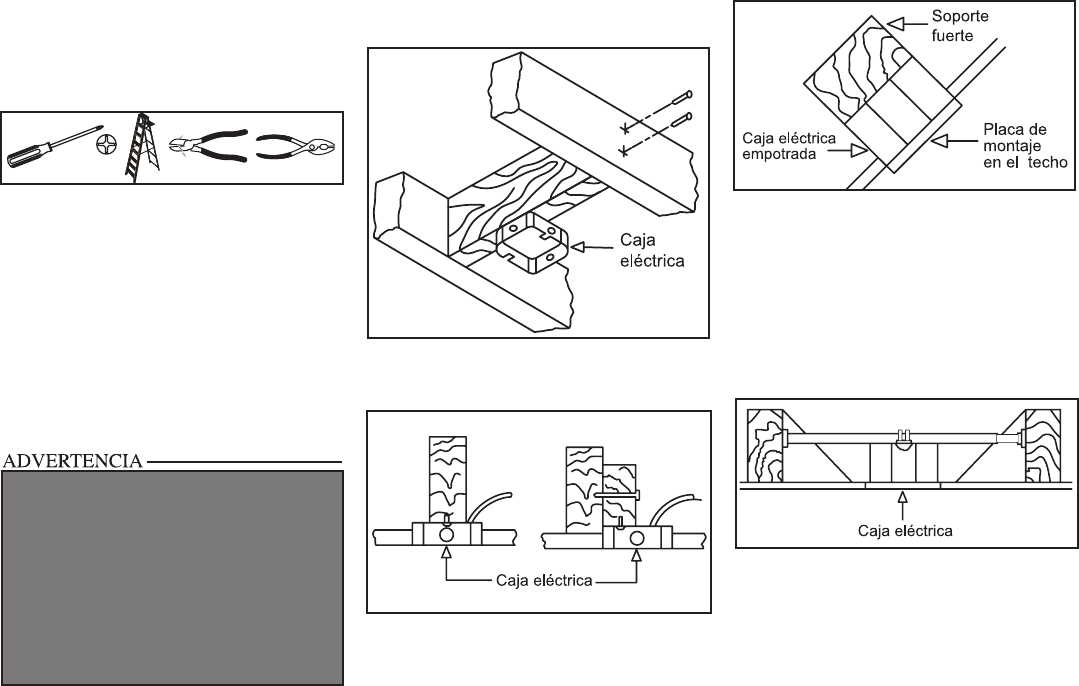
3. Cómo instalar el ventilador
Herramientas
necesarias
Destornillador Phillips, destornillador plano,
llave ajustable, escalera de tijera y cortacables.
Opciones de montaje
Si no hay una caja de montaje existente,
entonces lee las siguientes instrucciones.
Desconecta la energía retirando los fusibles
o apagando los cortacircuitos.
Asegura la caja eléctrica directamente a la
estructura de la edicación. Usa sujetadores y
materiales de construcción apropiados. La caja
eléctrica y su soporte deben sostener comple-
tamente el peso en movimiento del ventilador
(al menos 35 libras).
No uses cajas eléctricas de plástico.
Las guras 1, 2 y 3 son ejemplos de diferentes
maneras de montar la caja eléctrica.
Nota: Tal vez necesites un tubo bajante más
largo para mantener la altura mínima adecuada
de las aspas al instalar el ventilador en un techo
inclinado. El ángulo máximo permitido es de
30º. Si la cubierta toca el tubo bajante, retira
la cubierta inferior decorativa y gira la cubi-
erta 180º antes de jar la cubierta al soporte
de montaje.
Para colgar tu ventilador donde haya una lám-
para pero ninguna viga de techo, tal vez neces-
ites una barra colgante de instalación como se
muestra en la gura 4 (disponible en la tienda
minorista local de Hampton Bay).
PARA REDUCIR EL RIESGO DE INCENDIO,
DESCARGA ELÉCTRICA O LESIONES PERSO-
NALES, MONTA EL VENTILADOR SOBRE UNA
CAJA ELÉCTRICA MARCADA COMO “APRO-
BADA COMO SOPORTE DE VENTILADORES DE
35 LB (15,9 KG) O MENOS”, Y USA LOS TOR-
NILLOS DE MONTAJE QUE VIENEN CON LA
MISMA. LAS CAJAS ELÉCTRICAS UTILIZADAS
COMÚNMENTE PARA EL SOPORTE DE ARTÍCU-
LOS DE ILUMINACIÓN PUEDEN NO SERVIR
COMO SOPORTE DE VENTILADOR, Y TAL VEZ
DEBAN REEMPLAZARSE. EN CASO DE DUDA,
CONSULTA A UN ELECTRICISTA CALIFICADO.
Figura 1
Figura 2
Figura 4
Figura 3
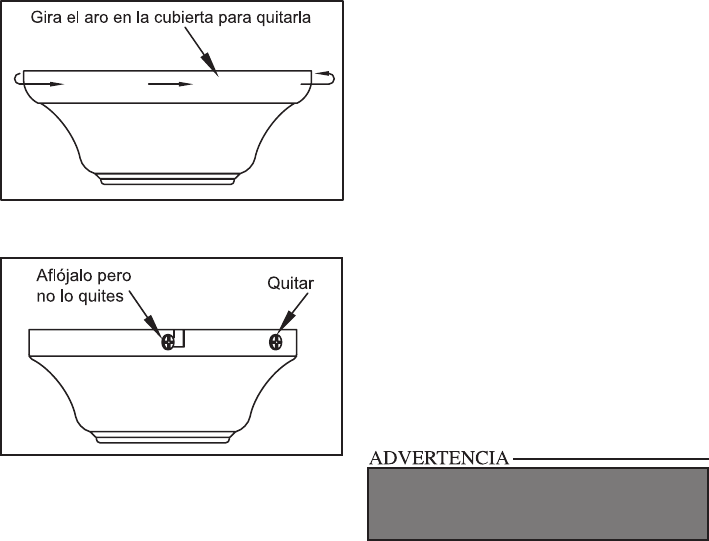
4.
Cómo colgar el
ventilador
RECUERDA desconectar la corriente.
Sigue estos pasos para colgar correctamente tu
ventilador.
NOTA: Se recomienda instalar este ventilador
en un techo estándar usando el tubo bajante
suministrado con el ventilador. Cuando uses
una instalación de techo estándar con el tubo
bajante de 6 pulgadas suministrado, la distan-
cia desde el techo a la parte inferior de las as-
pas será de 12 pulgadas aproximadamente.
Montaje de techo estándar
1. Retira el aro en la cubierta, girando el aro a
la derecha hasta destrabarlo (Figura 5).
2. Retira la placa de montaje de la cubierta
aojando los cuatro tornillos de la parte
superior de la misma. Quita los dos tornil-
los sin ranura y aoja los tornillos ranura-
dos. Esto te permitirá retirar la placa de
montaje (Figura 6).
3. Inserta los cables para que salgan por la
parte superior del motor del ventilador a
través de la cubierta decorativa del collarín
del motor. Asegúrate de que las aberturas
en forma de ranura estén en la parte superi-
Figura 5
Figura 6
or. Inserta los cables a través de la cubierta
y luego a través del ensamblado del tubo
bajante y la bola (Figura 7).
4. Aoja, sin quitarlos, los 2 tornillos en el col-
larín ubicado en la parte superior de la car-
casa de motor.
5. Alinea los oricios en la parte inferior del
tubo bajante con los oricios en el collarín
de la parte superior de la carcasa de motor
(Figura 7). Inserta con cuidado el pasador de
apoyo a través de los oricios del collarín y
del tubo bajante. Ten cuidado no apretarlo
contra el cableado dentro del tubo bajante.
Inserta el pasador de cierre en el oricio cer-
cano al extremo del perno hasta que quede
encajado en su posición como se muestra en
el círculo de la Figura 7.
6. Vuelve a ajustar los tornillos del collarín en la
parte superior de la carcasa del motor .
7. Asegúrate de que el ojal esté instalado cor-
rectamente en la cubierta del collarín, luego
desliza la cubierta del collarín por el tubo ba-
jante hasta que quede en la carcasa del motor.
Asegúrate de que la cubierta y la cubierta del
collarín tengan la orientación apropiada.
8. Sigue con la sección “Cómo instalar el
ventilador”.
SI NO COLOCAS CORRECTAMENTE LOS TOR-
NILLOS SEGÚN LO INDICADO EN EL PASO 6
SE PUEDEN AFLOJAR Y POSIBLEMENTE SE
CAIGA EL VENTILADOR.
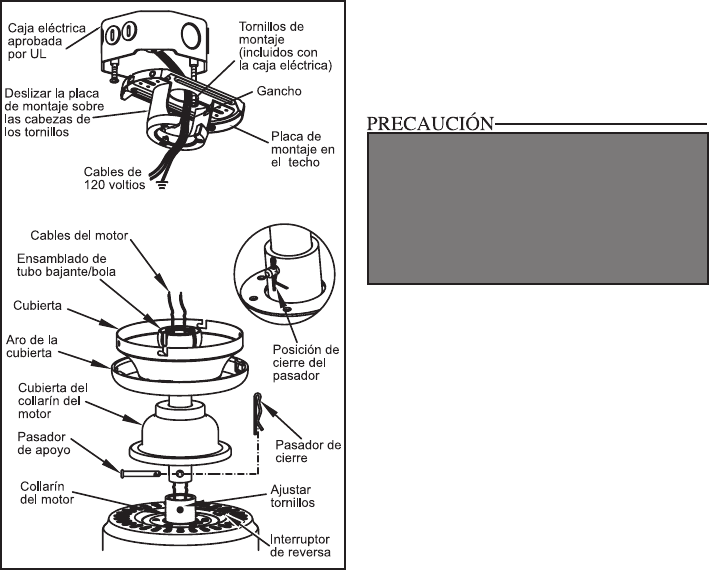
5.
Figura 7
Cómo instalar el
ventilador en la
caja eléctrica
1. Pasa los cables de suministro de 120 volt-
ios a través del oricio central de la placa
de montaje del techo como se muestra en la
Figura 7.
2. Instala la placa de montaje del techo en la
caja eléctrica deslizando la placa de mon-
taje sobre los dos tornillos provistos con la
caja eléctrica (Figura 7). Si es necesario, usa
arandelas niveladoras (no incluidas) entre la
placa de montaje y la caja eléctrica. Nota
que el lado plano del soporte de montaje
está hacia la caja eléctrica (Figura 7).
3. Ajusta rmemente los dos tornillos de mon-
taje.
4. Con cuidado alza el ensamblado del ventila-
dor hasta la placa de montaje. Asegúrate de
que la pestaña sobre la placa de montaje en-
caje bien en la ranura de la bola de soporte.
Cómo hacer las
conexiones eléctricas
RECUERDA desconectar la electricidad. Si
crees que no tienes suciente experiencia o
conocimientos en cableado eléctrico, contrata a
un electricista con licencia para que instale el
ventilador.
Sigue estos pasos para conectar tu ventilador a
tu circuito doméstico. Usa las tuercas de con-
exión de cable provistas con el ventilador y
el control remoto. Asegura los conectores con
cinta aislante. Asegúrate de que no haya cables
o conexiones sueltas (Figura 8).
1. Conecta el conductor a tierra del cable de
120 voltios (puede ser un cable desnudo o
un cable con aislante verde) al (los) cable(s)
terminal(es) a tierra verdes del ventilador
(Figura 8).
2. Conecta el cable blanco de motor del ven-
tilador al cable blanco del receptor, usando
una tuerca de cable (Figura 8).
3. Conecta el cable negro del motor del venti-
lador al cable negro del receptor usando una
tuerca de cable (Figura 8).
4. Conecta el cable azul del motor del venti-
lador al cable azul del receptor usando una
tuerca de cable (Figura 8).
CUANDO MONTES EL VENTILADOR EN UN
TECHO INCLINADO, DEBES USAR EL MÉTODO
DE MONTAJE CON TUBO BAJANTE Y BOLA ES-
TÁNDAR. LA PLACA DE MONTAJE DEBE ESTAR
INSTALADA DE MANERA TAL QUE LAS ABER-
TURAS EN FORMA DE RANURA QUEDEN EN EL
LADO INFERIOR, DESLIZANDO LA PLACA DE
MONTAJE DESDE LA PARTE SUPERIOR HACIA
ABAJO.
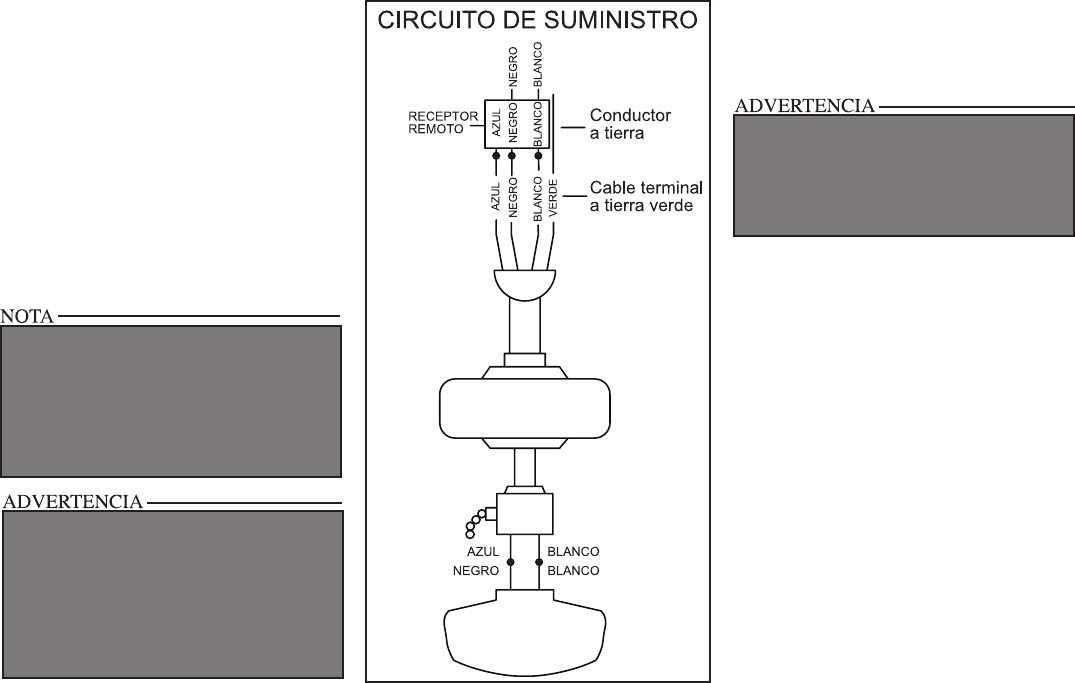
6.
5. Conecta el cable negro del receptor al cable
negro de suministro de energía (positivo)
usando una tuerca de cable (Figura 8).
6. Conecta el cable blanco del receptor al cable
blanco de energía (neutro) usando una tu-
erca de cable (Figura 8).
7. Después de conectar los cables, sepáralos
de manera que los cables verde y blanco
queden de un lado de la caja eléctrica y el
cable negro del otro.
8. Gira las tuercas de conexión del cable hacia
arriba y coloca con cuidado el cableado den-
tro de la caja eléctrica.
CADA TUERCA DEL CABLE (CONECTOR DE CA-
BLE) PROVISTA CON ESTE VENTILADOR ESTÁ
DISEÑADA PARA ACEPTAR HASTA UN CABLE
DOMÉSTICO CALIBRE 12 Y DOS CABLES DEL
VENTILADOR. SI TIENES UN CABLEADO DO-
MÉSTICO DE CALIBRE SUPERIOR A 12 O MÁS
DE UN CABLE DOMÉSTICO PARA CONECTAR
EL CABLEADO DEL VENTILADOR, CONSULTA
A UN ELECTRICISTA PARA EL TAMAÑO ADEC-
UADO DE TUERCAS DE CABLE.
LAS FRECUENCIAS DEL RECEPTOR Y TRANS-
MISOR HAN SIDO PRECONFIGURADAS EN LA
FÁBRICA. ANTES DE INSTALAR EL RECEPTOR,
ASEGÚRATE DE QUE LOS INTERRUPTORES
DEL RECEPTOR Y DEL TRANSMISOR ESTÉN
CONFIGURADOS EN LA MISMA FRECUENCIA.
LOS INTERRUPTORES DEL TRANSMISOR ES-
TÁN UBICADOS DENTRO DEL COMPARTIMEN-
TO DE LA BATERÍA.
Fin de la instalación
del ventilador
MONTAJE DE TECHO ESTÁNDAR
1. Alinea las ranuras de cierre de la cubierta
de techo con los dos tornillos de la placa de
montaje. Alza para enganchar las ranuras y
gira de izquierda a derecha para asegurar en
su sitio. Ajusta con rmeza los dos tornillos
de montaje.
2. Instala los dos tornillos de montaje restant-
es en los oricios de la cubierta y aprieta
rmemente.
3. Instala el aro de cubierta decorativa alinean-
do las ranuras del aro con los tornillos en la
cubierta. Rota el aro en sentido contrario a
las manecillas del reloj para jarlo.
4. Ahora puedes proceder a montar las aspas
del ventilador
Figura 8
CUANDO USES EL MONTAJE DE TUBO BAJANTE
Y BOLA ESTÁNDAR, LA PESTAÑA EN EL ARO EN
LA PARTE INFERIOR DE LA PLACA DE MONTAJE
DEBE ENCAJAR EN LA RANURA DE LA BOLA DE
SOPORTE. SI NO ENCAJA CORRECTAMENTE,
SE PUEDE DAÑAR EL CABLEADO.
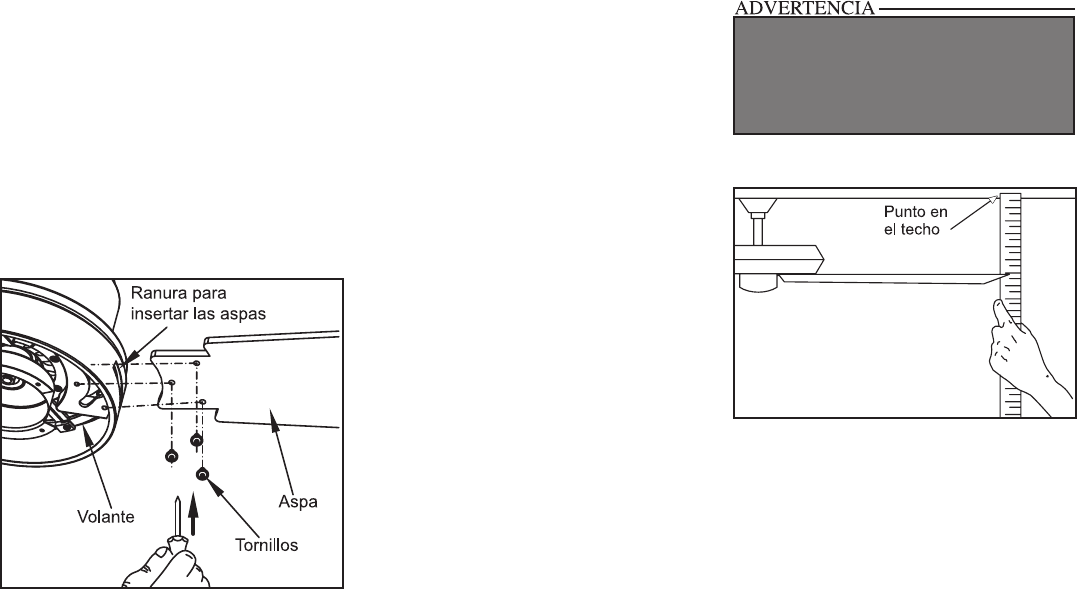
7.
Cómo montar las
aspas del ventilador
1. Inserta el aspa en la abertura en el centro
del volante, alinea los tres oricios para tor-
nillo en el aspa con los oricios para tornillo
en el volante y asegúrala con los tornillos
incluidos (Figura 9).
2. Repite para las aspas restantes.
Figura 9
Figura 10
Equilibrar las aspas
Todas las aspas se agrupan por peso. Como las
maderas naturales varían en densidad, el venti-
lador puede oscilar aunque las aspas tengan el
mismo peso.
El siguiente procedimiento corregirá en gran
medida la oscilación del ventilador. Verica
después de cada paso.
1. Verica que todos los tornillos de las aspas
estén seguros.
2. La mayoría de los problemas de oscilación
del ventilador se deben a que las aspas no
están a un mismo nivel. Verica este nivel
seleccionando un punto en el techo sobre la
punta de una de las aspas. Mide desde un
punto en el centro de cada aspa a un punto
en el techo. Mide esta distancia como se
muestra en la gura 10. Rota el ventilador
hasta que se posicione la siguiente aspa para
su medición. Repita para cada aspa. Las
desviaciones de la medición deben estar
dentro de 1/8”. Enciende el ventilador por
10 minutos. Si el ventilador continúa osci-
lando, comunícate con el servicio al cliente
y te enviarán un kit de compensación de as-
pas, sin costo alguno.
PARA REDUCIR EL RIESGO DE LESIONES PER-
SONALES, NO DOBLAR LOS SOPORTES DE LAS
ASPAS DURANTE LA INSTALACIÓN, COMPEN-
SACIÓN DE LAS ASPAS O LIMPIEZA DEL VEN-
TILADOR. NO INSERTES OBJETOS ENTRE LAS
ASPAS EN FUNCIONAMIENTO.
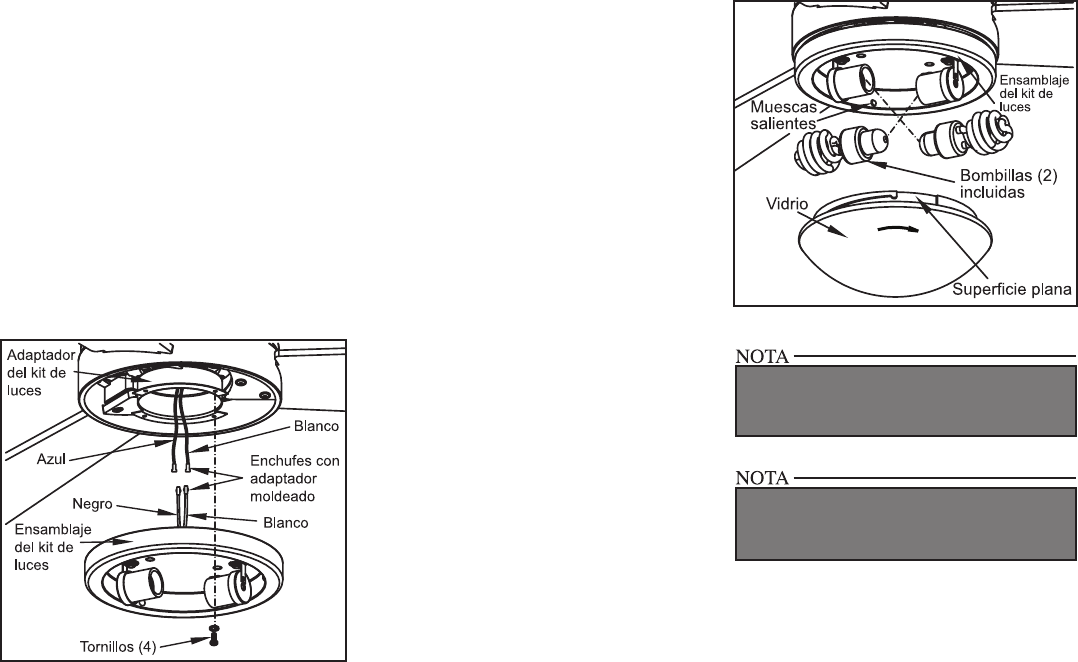
8.
Cómo instalar el kit de
luces/tazón de vidrio
PRECAUCIÓN - Para disminuir el riesgo de
descarga eléctrica, desconecta el circuito de en-
ergía del ventilador antes de instalar el kit de
luces.
EL VIDRIO ES FRÁGIL, TEN CUIDADO AL
INSTALAR EL KIT DE LUCES Y LA PAN-
TALLA DE VIDRIO .
1. Aoja, pero no quites, tres de los tornillos de
montaje del adaptador del kit de luces deba-
jo del ensamblaje del motor del ventilador,
retira un tornillo de montaje (Figura 11).
2. Conecta el cable azul y el cable blanco que
salen del adaptador del kit de luces con el
cable negro y el cable blanco del ensamblaje
del kit de luces, enganchando los enchufes
con adaptador moldeado (azul con negro,
blanco con blanco).
3. Coloca con cuidado los conectores dentro
del adaptador del kit de luces. Coloca el en-
samblaje del kit de luces en el adaptador del
kit de luces, alineando cada uno de los cua-
tro oricios. Rota el ensamblaje del kit de
luces de izquierda a derecha para enganchar
los tres tornillos de montaje con los tres ori-
cios tipo ojo de cerradura, ajusta los tornil-
los. Reinstala el tornillo de montaje que reti-
raste en el paso 1 y apriétalo rmemente.
4. Con el ventilador apagado, instala las dos
bombillas uorescentes (máximo 14 vatios,
incluidas) ajustándolas en el portabombillas
(Figura 12).
5. Coloca la pantalla de vidrio en el ensambla-
je del kit de luces, alineando las tres áreas
planas en el reborde superior de la pantalla
de vidrio con las tres muescas salientes del
ensamblaje del kit de luces. Gira la pantalla
de vidrio de izquierda a derecha hasta que se
detenga (Figura 12).
Figure 11
Figura 12
VERIFICA CON FRECUENCIA QUE EL VIDRIO
ESTÉ AJUSTADO POR COMPLETO DE IZQUI-
ERDA A DERECHA EN EL ENSAMBLAJE DEL
KIT DE LUCES.
ESPERA QUE LA BOMBILLA SE ENFRÍE POR
COMPLETO ANTES DE TOCARLA O DE REEM-
PLAZARLA PARA EVITAR QUEMADURAS ACCI-
DENTALES EN LA PIEL.
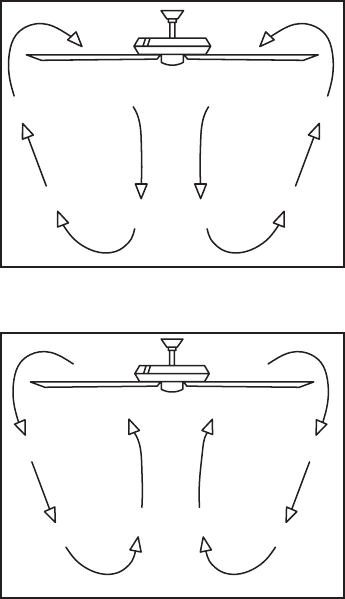
9. Cómo operar el ventilador
Las conguraciones de velocidad para clima
cálido o frío dependen de factores como tamaño
de la habitación, altura del techo, cantidad de
ventiladores y demás.
Este ventilador se envía desde la fábrica con el
interruptor de reversa posicionado para hacer
circular el aire hacia abajo Si deseas dirigir la
corriente de aire en la dirección contraria, apaga
el ventilador y espera que las aspas se detengan,
luego desliza el interruptor de reversa (ubicado
en la caja de interruptores, consulta la Figura
7 de la página 5) hacia la dirección opuesta y
luego vuelve a prender el ventilador. Las aspas
del ventilador girarán en sentido contrario y re-
vertirán la dirección de la corriente de aire.
Figura 13
Figura 14
Clima cálido - (Hacia adelante) Un ujo de
aire hacia abajo crea un efecto refrescante como
se muestra en la gura 13. Esto te permite jar
tu aire acondicionado en una conguración más
alta sin afectar tu comodidad.
Clima fresco - (Reversa) Un ujo de aire hacia
arriba mueve el aire cálido lejos del techo como
se muestra en la Figura 14. Esto te permite jar
tu unidad de calefacción en una conguración
más baja sin afectar tu comodidad.
Cómo manejar el control remoto 10.
Cómo poner en
funcionamiento el
ventilador:
Tecla Hi - Velocidad alta
Tecla Med - Velocidad media
Tecla Low - Velocidad baja
Tecla Off - Apagado
Tecla Light - Encender/Apagar la luz
Control remoto
Tu ventilador está equipado con un control re-
moto que controla la velocidad y las luces de
tu ventilador de techo. Para más información
sobre cómo instalar el control remoto, consulta
las instrucciones del control remoto y revisa los
componentes incluidos con éste.
Funcionamiento del
transmisor
NOTA: Este control remoto está equipado
con 16 combinaciones de códigos. Para evi-
tar posibles interferencias desde o hacia otras
unidades remotas como los abrepuertas de ga-
rajes, alarmas de autos o sistemas de seguridad,
simplemente cambia el código de combinación
pero asegúrate de que el código del transmi-
sor de mano y del receptor del ventilador sean
iguales.
Instala una batería de 9 voltios (no incluida).
Cómo congurar
el código
Esta unidad tiene 16 combinaciones de códigos
diferentes. Para congurar el código, sigue los
siguientes pasos:
A. Congurar el código del transmisor:
a. Retira la cubierta de la batería. Presiona
con rmeza debajo de la echa y retira la
cubierta de la batería deslizándola.
b. Desliza los interruptores de código según
tu elección hacia arriba o hacia abajo.
(Todas las conguraciones de fábrica son
hacia arriba).
B. Congurar el código del receptor.
a. Desliza los interruptores de código hacia
la misma posición que elegiste para el
transmisor.
b. Vuelve a colocar la cubierta de la batería
del transmisor.
PRECAUCIÓN:
El ángulo del techo no debe exceder los
30 grados.
Modelo de controlador: UC7067RYK

11. Cuidado del ventilador y solución de problemas
Cuidado del
Ventilador
Aquí tienes algunas sugerencias para el manten-
imiento de tu ventilador.
1. Debido al movimiento natural del ventila-
dor, algunas conexiones pueden aojarse.
Revisa las conexiones de soporte, soportes
y accesorios de aspas dos veces al año.
Asegúrate de que estén seguros. (No es nec-
esario desmontar el ventilador del techo).
2. Limpia tu ventilador con frecuencia, para
que luzca como nuevo a pesar de los años.
No uses agua al limpiar, esto puede dañar
el motor o la madera, o causar descargas
eléctricas. Usa solamente un cepillo suave
o trapo sin pelusas para evitar arañar el aca-
bado. El revestimiento está sellado con laca
para minimizar la decoloración u opacidad.
Advertencia: Asegúrate de que la corriente
esté apagada antes de limpiar el ventilador.
3. Puedes aplicar una na capa de pulimento
para muebles a la madera para una mayor
protección y belleza. Cubre los arañazos
pequeños con una leve aplicación de lustra-
dor para calzado.
4. Tu ventilador no necesita lubricación. El
motor tiene cojinetes de bola sellados per-
manentemente lubricados.
El ventilador no
enciende
El ventilador hace
ruido
1. Verica fusibles o disyuntores principales y secundarios.
2. Verica conexiones de cables en línea al ventilador y conexiones de cables
del interruptor en la caja de interruptores. PRECAUCIÓN: Asegúrate
de que esté desactivada la electricidad principal.
3. Verica las baterías en el transmisor. ¿Se enciende la luz LED roja?
¿Estás lo sucientemente cerca del ventilador? (El rango normal es de
10-12 pies) ¿Coinciden las conguraciones del interruptor en el trans-
misor (unidad de mano) y el receptor? RECUERDA DESCONEC-
TAR LA ELECTRICIDAD ANTES DE VERIFICAR LAS CON-
FIGURACIONES DEL INTERRUPTOR EN EL RECEPTOR.
1. Asegúrate de que los tornillos de la carcasa del motor estén ajustados.
2. Asegúrate de que los tornillos que unen el soporte de aspa al cuerpo del
motor están bien ajustados.
3. Asegúrate de que las conexiones de tuerca de cable no choquen
unas con otras o con la pared interior de la caja del interruptor.
PRECAUCIÓN: Asegúrate de que esté desconectada la electricidad.
4. Permite un período de 24 horas de “adaptación”. La mayoría de los ruidos
asociados con un nuevo ventilador desaparecen en ese período.
5. Si usas el kit de luces de ventilador de techo, asegúrate de que los tornillos
que sujetan el vidrio estén bien colocados. Verica que la bombilla de luz
esté bien asegurada.
6. Asegúrate de que la cubierta esté a corta distancia del techo. No debe
tocar el techo.
7. Asegúrate de que tu caja eléctrica esté bien segura y las almohadillas
aislantes de goma se hayan instalado entre el soporte de montaje y la caja
de distribución.
Solución de problemas
Problema Solución
ASEGÚRATE DE QUE ESTÉ DESCONECTADA LA ELECTRICIDAD EN EL
PANEL DE ELECTRICIDAD ANTES DE INTENTAR HACER REPARACIONES.
CONSULTA LA SECCIÓN “CÓMO HACER LAS CONEXIONES ELÉCTRICAS”.

Especicaciones 12.
TAMAÑO VELOCIDAD VOLTIOS AMPERIOS VATIOS RPM
PIES
CÚB. X
MIN.
PESO
NETO
PESO
BRUTO
PIES
CÚB
52”
Baja 120 0.29 13 64 1584
18.7
Lbs
21.2
Lbs 1.76Media 120 0.44 33 128 3234
Alta 120 0.52 62 175 4575
Estas medidas son aproximadas. No incluyen ni el amperaje ni el vataje consumido por el kit de luces.
Distribuido por Home Depot U.S.A., Inc.
2455 Paces Ferry Rd. N.W. Atlanta, Georgia 30339
Número del proveedor: 11688
Este equipo ha sido probado y se determinó que cumple con los límites establecidos para un dispositivo digital Clase B, de acuerdo con la Parte 15 de las Normas
de la FCC. Estos límites fueron establecidos para ofrecer protección razonable contra la interferencia dañina durante uso residencial. Este equipo genera, usa y
puede irradiar energía de radiofrecuencia y, si no se instala y usa de acuerdo con las instrucciones, puede causar interferencia dañina a comunicaciones radiales.
Sin embargo, no hay garantía de que no ocurrirá interferencia en una instalación particular. Si este equipo causa interferencia que perjudica la recepción de radio
o televisión, lo cual puede determinarse encendiendo y apagando el equipo, se recomienda al usuario que trate de corregir la interferencia con una o más de las
siguientes medidas:
– reorientar o reubicar la antena receptora.
– incrementar la distancia entre los equipos y el receptor.
– conectar el equipo a un tomacorriente en un circuito distinto al que el receptor está conectado.
– consultar al distribuidor o algún técnico de radio/TV con experiencia.
PRECAUCIÓN:
Los cambios o modicaciones sin aprobación expresa del responsable de este dispositivo podrían anular el derecho del usuario a operar el equipo.
Este dispositivo cumple con la Parte 15 de las Normas de la FCC. Su operación está sujeta a las dos condiciones siguientes: (1) este dispositivo no debe causar
interferencia dañina, y (2) este dispositivo tiene que aceptar cualquier interferencia recibida, incluyendo aquella que pueda afectar su funcionamiento.
Este equipo ha sido probado y se determinó que cumple con los límites establecidos para un dispositivo digital Clase B, de acuerdo con la Parte 15 de las Normas
de la FCC. Estos límites fueron establecidos para ofrecer protección razonable contra la interferencia dañina durante uso residencial. Este equipo genera, usa y
puede irradiar energía de radiofrecuencia y, si no se instala y usa de acuerdo con las instrucciones, puede causar interferencia dañina a comunicaciones radiales.
Sin embargo, no hay garantía de que no ocurrirá interferencia en una instalación particular. Si este equipo causa interferencia que perjudica la recepción de radio
o televisión, lo cual puede determinarse encendiendo y apagando el equipo, se recomienda al usuario que trate de corregir la interferencia con una o más de las
siguientes medidas:
– reorientar o reubicar la antena receptora.
– incrementar la distancia entre los equipos y el receptor.
– conectar el equipo a un tomacorriente en un circuito distinto al que el receptor está conectado.
– consultar al distribuidor o algún técnico de radio/TV con experiencia.
PRECAUCIÓN:
Los cambios o modicaciones sin aprobación expresa del responsable de este dispositivo podrían anular el derecho del usuario a operar el equipo.
Este dispositivo cumple con la Parte 15 de las Normas de la FCC. Su operación está sujeta a las dos condiciones siguientes: (1) este dispositivo no debe causar
interferencia dañina, y (2) este dispositivo tiene que aceptar cualquier interferencia recibida, incluyendo aquella que pueda afectar su funcionamiento.

13. Información de la garantía
Garantía limitada de por vida de Hampton Bay –
Garantía de por vida para el motor
Hampton Bay garantiza de por vida, a partir de la fecha de compra por el comprador original, que el
motor del ventilador no presenta defectos de fabricación ni de material desde la fecha de salida de
la fábrica. Hampton Bay también garantiza por un período de un año, a partir de la fecha de compra
por el comprador original, que todas las demás piezas del ventilador, sin incluir ninguna aspa de
vidrio o acrílico, no presentarán ningún defecto de fabricación o de material desde el momento de
su salida de la fábrica. Acordamos reparar todos los defectos del tipo antes mencionado, sin cargo
alguno, o a nuestra discreción, reemplazar el producto por un modelo de calidad comparable o supe-
rior si el producto se devuelve a Hampton Bay. Para obtener una garantía de servicio debe presentar
una copia del recibo como comprobante de compra. Todos los costos de retiro y reinstalación del
producto son su responsabilidad. Daños a cualquiera de las piezas como resultado de accidentes, in-
stalación o uso incorrectos o debidos a la instalación de cualquier accesorio, no están cubiertos bajo
esta garantía. Debido a que las condiciones climáticas pueden variar, esta garantía no cubre ningún
cambio en el acabado revestido, incluyendo óxido, picaduras, corrosión, manchas o descascara-
miento. Los acabados de bronce de este tipo tienen una vida útil más prolongada cuando se protegen
de las condiciones climáticas cambiantes. Es normal cierta “oscilación” y no se considerará una
falla. Cualquier servicio técnico conducido por personas no autorizadas anulará la garantía. No hay
ninguna otra garantía expresa. Mediante la presente Hampton Bay se exime de cualquier garantía,
incluyendo pero sin limitarse a aquellas de comercialización e idoneidad para un n particular, de
acuerdo a lo contemplado por la ley. La duración de cualquier garantía implícita que no se pueda
eximir, está limitada al período de tiempo especicado en la garantía explícita. Algunos estados no
permiten limitaciones en la duración de la garantía, por consiguiente la limitación anterior puede
no aplicarse a usted. Hampton Bay no será responsable por daños directos, indirectos o especiales
que resulten o deriven del uso o rendimiento del producto excepto en casos en que lo estipule la ley.
Algunos estados no permiten la exclusión o limitación de daños directos o indirectos, por lo que la
limitación o exclusión anterior podría no aplicarse a usted. Esta garantía le otorga derechos legales
especícos pero es posible que también tenga otros derechos que varían de un estado a otro. Esta
garantía sustituye todas las garantías anteriores. Los costos de envío de cualquier devolución de
productos hecha como parte de una reclamación de garantía deben ser pagados por el cliente.
NOTA IMPORTANTE:
Para asegurar la garantía de servicio, si es
necesario, registre su ventilador en:
gpwarranty.com
Para obtener una garantía de servicio debe pre-
sentar una copia del recibo original de compra.
G.P. WARRANTY SERVICE CENTER, INC.
WARRANTY SECTION
1951 N.W. 22nd STREET
FORT LAUDERDALE, FLORIDA 33311
Adjunte recibo aquí para
facilitar la localización.